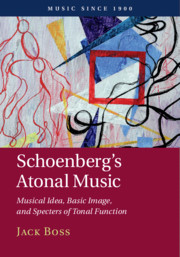Refine search
Actions for selected content:
12 results

Schoenberg in Context
-
- Published online:
- 04 September 2025
- Print publication:
- 04 September 2025
Chapter 10 - Tonality
- from Part III - Approaches to Composition
-
-
- Book:
- Schoenberg in Context
- Published online:
- 04 September 2025
- Print publication:
- 04 September 2025, pp 99-107
-
- Chapter
- Export citation
7 - Envoicing Absence
-
- Book:
- Anton Webern at the Dawn of Modernism
- Published online:
- 21 August 2025
- Print publication:
- 04 September 2025, pp 148-170
-
- Chapter
- Export citation
3 - Zarathustrian Transfigurations
-
- Book:
- Anton Webern at the Dawn of Modernism
- Published online:
- 21 August 2025
- Print publication:
- 04 September 2025, pp 58-84
-
- Chapter
- Export citation
Chapter 11 - Atonality
- from Part III - Approaches to Composition
-
-
- Book:
- Schoenberg in Context
- Published online:
- 04 September 2025
- Print publication:
- 04 September 2025, pp 108-121
-
- Chapter
- Export citation
1 - Prelude: Earliness as a Historiographical Category
-
- Book:
- Anton Webern at the Dawn of Modernism
- Published online:
- 21 August 2025
- Print publication:
- 04 September 2025, pp 11-25
-
- Chapter
- Export citation
13 - Contesting Analytical Traditions
- from Part IV - Scholarship
-
-
- Book:
- The Cambridge Companion to <i>The Rite of Spring</i>
- Published online:
- 28 June 2025
- Print publication:
- 17 July 2025, pp 257-272
-
- Chapter
- Export citation
3 - Before Erwartung
-
- Book:
- Schoenberg: ‘Night Music' – <i>Verklärte Nacht and Erwartung</i>
- Published online:
- 30 November 2023
- Print publication:
- 30 November 2023, pp 38-60
-
- Chapter
- Export citation
Chapter 17 - The Compositional Context
- from Part III - Britten and Other Composers
-
-
- Book:
- Benjamin Britten in Context
- Published online:
- 31 March 2022
- Print publication:
- 21 April 2022, pp 147-154
-
- Chapter
- Export citation
Chapter 23 - The Avant-Garde
- from Part III - Britten and Other Composers
-
-
- Book:
- Benjamin Britten in Context
- Published online:
- 31 March 2022
- Print publication:
- 21 April 2022, pp 200-212
-
- Chapter
- Export citation
1 - Tonal oder Atonal?
-
- Book:
- Schoenberg's Atonal Music
- Published online:
- 28 June 2019
- Print publication:
- 04 July 2019, pp 1-40
-
- Chapter
- Export citation

Schoenberg's Atonal Music
- Musical Idea, Basic Image, and Specters of Tonal Function
-
- Published online:
- 28 June 2019
- Print publication:
- 04 July 2019
